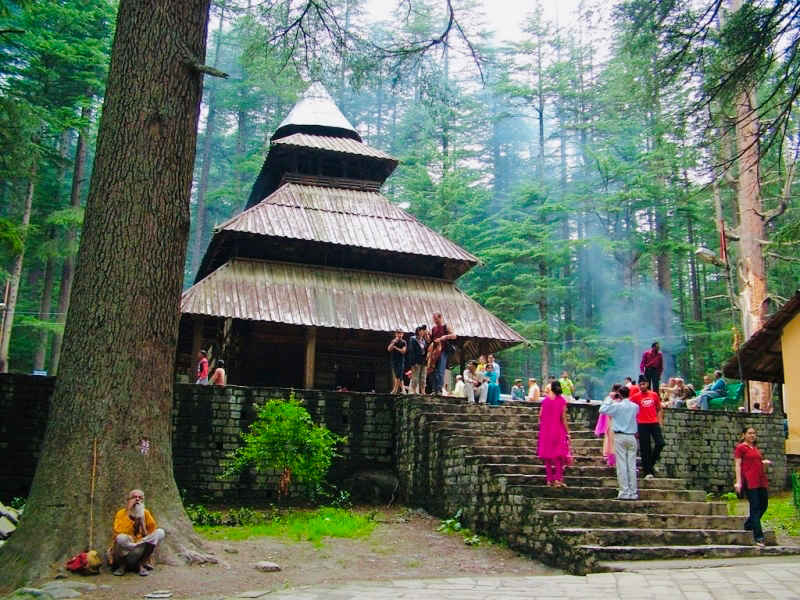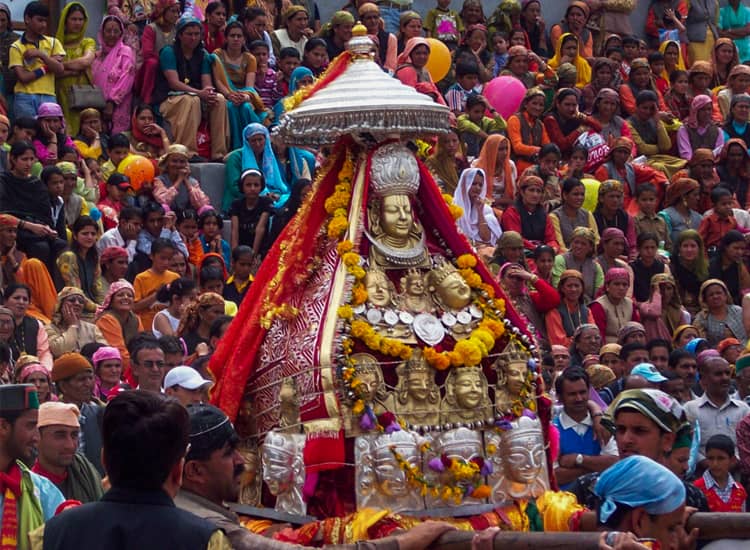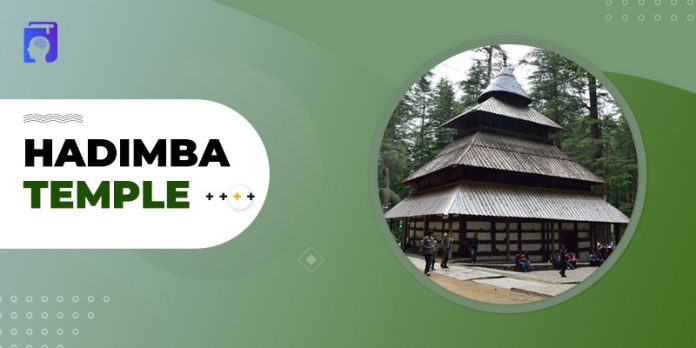Amidst the snow-covered slopes of Manali, The Hadimba Temple is dedicated to Hidimba Devi, Bhima’s wife, and Ghatothkach’s mother. Surrounded by magnificent cedar trees, the temple is situated on a rock that is said to be a form of goddess Hidimba herself. The Hidimba Devi temple, also known as Dhungari Temple, has wooden doors, walls, and a cone-shaped roof, representing a unique architecture exclusive to the region.
Hadimba Temple: Architecture, Best Timing, Attractions & Festivals
How to Reach the Hadimba Temple?

The Hadimba Devi Temple, located in Manali, Himachal Pradesh, can be reached via:
By Air: Hadimba Temple is 52.5 kilometers from Kullu-Manali Airport in Bhuntar. You may hire a vehicle from the airport to the temple, which will take 2 to 2.5 hours.
By Rail: The place is 165.3 kilometers from Joginder Nagar railway station.
By Bus: Manali is accessible to major cities in North India. A lot of buses travel daily from Delhi to Manali. Seat availability should not be an issue at any time, whether in private semi-sleepers or state-run buses.
This temple is about 2 kilometers from Manali’s main city center and can be reached by bus, taxi, or foot. Its entrance timings are 8:00 am to 6:00 pm.
What is the Best Time to Visit the Hadimba Temple?

The Hadimba Temple is open all year round. Manali is blanketed in snow throughout the winter and the temple is a sight to behold. But the best time to visit the Hadimba temple is from the first week of July and the last week of August. The entrance timing of the temple is from 8 AM to 6 PM from Monday to Sunday and it would take around 2 hours to complete the visit.
The Architecture of Hadimba Temple
The Hadimba Temple is a four-story pagoda-style structure with flat roofs. The conical highest roof is made of metal, while the others are made of wood tiles. The temple is mostly constructed of wood and stones. Above the temple is a 24-meter-high wooden Shikhar or tower with beautifully carved wooden doors.
The Hadimba temple’s main entrance is decorated with sculptures representing Goddess Durga. The temple’s foundation is composed of whitewashed stones. The interior is simple yet attractive. Carvings and sculptures of Hindu Goddesses, animals, and other objects decorate the walls. Strangely, it lacks any idol of Devi Hidimba. The holiest object here is the rock on which Hidimba meditated. It’s a massive stone with her footprint.
History
True to its name, the Hadimba Temple is dedicated to Hidimba. Hidimba was a demon that resided with her brother Hidimb in this location. She had promised to marry anyone who could beat Hidimb in a battle. During the Pandavas’ exile, Bheem, the Pandavas’ second brother, killed Hidimb to free the people from his tortures, hence earning Hidimba’s hand in marriage. Her offspring, Ghatotkacha perished in action in the Mahabharata battle. Near the Hadimba temple is a temple dedicated to him.
Hidimba remained in Manali after Bheem, and the rest of Pandavas left. She was regarded to be a compassionate and just ruler. Hidimba gave her son Ghatotkacha the kingdom when he reached adulthood and retired to the jungle to devote the remainder of her life to meditation. Hidimba is supposed to have sat on a rock undergoing severe penance to lose her demonic nature. Her prayers were granted after multiple years of meditation, and she was anointed as a goddess. In 1553, the Hidimba Devi Temple was erected on this rock to commemorate her penance by Maharaja Bahadur Singh.
Festivals

- Every year in the month of Shravan, a festival named Bahadur Singh Re Jatra is held to honor Raja Bahadur Singh’s contribution to constructing this temple. This Mela is also known as Saroohni.
- Every year, on May 14th, a new music and dance fair commemorates Hadimba Devi’s birthday. If you want to immerse yourself in a different culture, visit Hadimba Temple in Manali and participate in these festivities.
- The idol of Devi Hidimba is carried to the Dhalpur Maidan during the Dussehra celebration when she blesses the ceremonial horse. This custom is known as “Ghor Puja”.
Things To Do
- Visit the surrounding valleys and pass.
- If you’ve had your fill of adventure, take some time to relax and meditate, letting go of any tension and tiredness.
- Set up camp in surrounding communities to get a sense of the local culture.
- Take photographs of local animals, such as fluffy goats and rabbits.
Food
There are plenty of food stalls nearby, such as Hidimba Fast food/Dhaba and Hidimba Cafe. To taste local delicacies, head straight to the Manali Resort’s in-house multi-cuisine restaurant. Otherwise, there are several vegetarian and nonvegetarian restaurants, such as Blue Elephant Cafe, Forno, Tandoori Platter, Paar Cafeteria and Restaurant, and The Green Forest Cafe.
Shopping

Lakkar Bazaar and the Mall are popular shopping places nearby. But while you are in Manali, check out the old Manali Market, Tibetan Market, or Manu Market which are popular shopping places in the town. The Old Manali market is near the Manu Temple, and the rest are in Siyal. Lakkar Bazaar is a delightful place to visit if you want to buy stunning wooden items for gifting.
Tips
- At the Hadimba Temple, be wary of touts as you exit your car.
- Visiting the temple during the peak season may result in parking problems.
- Try to visit the temple in May to enjoy the 3-day Dhungri/Hadimba festival. However, check the potential dates of the festival beforehand.
- You can capture photographs with yaks and rabbits at the Hadimba temple.
Interesting facts
The Hadimba Temple is a bit unusual and interesting. Here are a few more pieces of information about the place.
- On April 18, 1967, the temple was designated a Monument of National Importance because of its historical and architectural significance.
- The temple has also appeared in numerous Bollywood films, including Roja (1992) and Yeh Jawani Hai Diwani (2013).
- The native Manalians consider the temple as their supreme deity.
- The name of the Mandir, Hadimba came from Bhima’s wife.
- Hadimba was believed to be a goddess with some supernatural powers.
Attractions Nearby
Many neighboring places make your trip to the Hidimba Temple even more worthwhile. However, you shouldn’t be missing these three.
1. Malana
Malana is a historic, isolated Indian village northeast of Kullu Valley. It’s connected to Kullu via a few mountain passes. The magnificent peaks of Deo Tibba and Chandrakhani cast a shadow over the town. The culture is unique and the people are friendly.
2. Kullu
Kullu is the “Valley of Gods”, situated 1,230 meters above sea level. Tourists are drawn to this region by the picturesque vistas, towering rainforests, azure rivers, snow-clad peaks, and hospitable people.
3. Ghatotkacha Temple
As the name suggests, it’s dedicated to Ghatotkacha and situated a few meters from the Hadimba Shrine. It’s fashioned from a stone block that looks like Hidimba’s foot.
Conclusion
A legacy site saturated with mythology, the Hidimba Devi Temple is a significant place in Manali. Animal sacrifices are still conducted here in honor of the Devi. While the narrative of Hadimba Devi Temple may raise the eyebrows of atheists, the concept of a goddess defending the forests is enticing since the world desperately needs more such defenders. Next time you visit Manali, you won’t wish to miss this place of tranquillity, vibrance, and inspiration.
People are also reading:

